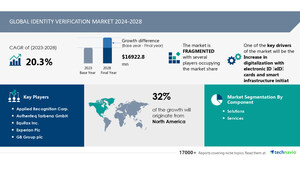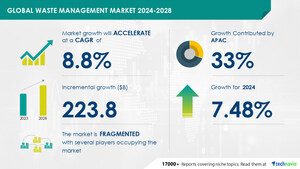NEW YORK, Feb. 28, 2024 /PRNewswire/ -- The "Sensor Market by Technology (CMOS, MEMS, NEMS, and Others), End-user (Electronics, IT and telecom, Automotive, Industrial, and Others), and Geography (North America, APAC, Europe, Middle East and Africa, and South America) - Forecast and Analysis 2023-2027" report has been added to Technavio's offering. With ISO 9001:2015 certification, Technavio has proudly partnered with more than 100 Fortune 500 companies for over 16 years. The potential growth difference for the sensor market between 2022 and 2027 is USD 274.2 billion. The rise in demand for IoT technology-based devices is the major factor notably driving the growth of the market. IoT technology facilitates the connection of multiple smart devices to streamline their function and share data between them. Multiple smart devices, such as smartphones, tablets, and wearables collect essential data from the device, which is then used to enhance the user experience. In addition, the rising requirement for data analytics and analytics integration is likely to drive the use of IoT-based devices. However, the Internet of Things plays an integral role in enhancing process automation and enhancing operational efficiency in various industries. IoT is also enhancing its skills in cold chain monitoring for temperature-sensitive food and pharmaceutical products. Therefore, the rising use of IoT-based devices is anticipated to fuel the growth of the global sensors market during the forecast period. Get deeper insights into the market size, current market scenario, future growth opportunities, major growth driving factors, the latest trends, and much more. Buy the full report here
Increasing usage of network-embedded systems
Advancements in digital telecommunications technology and the integration of multiple smart devices have led to the creation of integrated networks. Today's embedded systems deliver a combination of wired and wireless communication alternatives for integrating network functionality into devices. However, network-integrated systems are currently used in a broad variety of smart gadgets and electronic products, and they are connected with other smart devices to provide valuable communication and measurement knowledge information. through wireless sensor networks. In contrast, embedding sensors into a gadget expands the cost and shortens the life of the device. Therefore, such factors are anticipated to hinder the growth of the global sensors market during the forecast period. Read Free Sample PDF Report Now
The sensor market has been segmented by technology (CMOS, MEMS, NEMS, and Others), end-user (Electronics, IT and telecom, Automotive, Industrial, and Others), and geography (North America, APAC, Europe, Middle East and Africa, and South America).
- The market share growth by the CMOS segment will be significant during the forecast period. Complementary metal oxide semiconductors (CMOS) are known for their small form factor and integration capabilities. The growing use of complementary metal oxide semiconductor sensors in all smart devices is an important driver for this segment. The expansion of IoT devices and applications needs a variety of sensors, including CMOS sensors, to facilitate data collection, monitoring, and control in a variety of environments. The growing popularity of virtual reality (VR) and augmented reality (AR) technologies depend on CMOS sensors to track user movements and interactions. Thus, continued improvements in semiconductor manufacturing, leading to higher resolution, enhanced sensitivity, and improved performance of CMOS sensors, are anticipated to drive the growth of the segment during the forecast period.
- North America is estimated to account for 39% of the global market during the forecast period. View the Free Sample Report for insights into the contribution of all the segments and regional opportunities in the report.
Key Companies:
ABB Ltd., Amphenol Corp., ams OSRAM AG, Dwyer Instruments Inc., Honeywell International Inc., Johnson Controls International Plc, Microchip Technology Inc., NXP Semiconductors NV, OMRON Corp., Panasonic Holdings Corp., Qualcomm Inc., Robert Bosch GmbH, Rockwell Automation Inc., Siemens AG, Sony Group Corp., Spectris Plc, STMicroelectronics International N.V., TE Connectivity Ltd., Texas Instruments Inc., and Infineon Technologies AG
Analyst Review
The Industrial Sensor Market Dynamics are undergoing a significant transformation fueled by advancements in Industry 4.0 and the Industrial Internet of Things (IIoT). Manufacturers across various manufacturing industries are increasingly adopting sensor technologies to enhance visibility into their operations and drive production progress. These sensors play a crucial role in monitoring resource utilization, providing real-time data, and ensuring transparency throughout the production process.
Planning and scheduling operations have become more data-driven, leveraging real-time data from various sensor types such as temperature, pressure, vibration, and flow sensors. These sensors, coupled with advanced software and algorithms, offer valuable insights into process performance, identifying potential issues and enabling timely decisions to optimize production processes. By monitoring equipment health and implementing predictive maintenance programs, manufacturers can minimize downtime, breakdowns, and failures, thus maximizing production speed and ensuring efficient use of materials.
With control over products and processes, manufacturers can maintain competitive pricing while improving average selling prices and profit margins. Established players in the sensor market continue to invest in research and development, driving innovation to meet evolving industry demands. Meanwhile, new entrants are leveraging emerging technologies to disrupt traditional market landscapes.
In this dynamic landscape, end users across regions are increasingly relying on sensors to gain a competitive edge. Whether in automotive, healthcare, or manufacturing, sensors are integral to enhancing efficiency and profitability. By harnessing the power of sensor data and machine learning algorithms, manufacturers can proactively address maintenance interventions, reducing the risk of costly disruptions.
Moreover, sensors enable precise control over production processes, ensuring quality standards are met while meeting customer demands. This level of control facilitates the efficient use of resources and enables manufacturers to adapt to changing market dynamics swiftly. By continuously optimizing processes, manufacturers can achieve sustainable growth and maintain their position in the market.
In conclusion, the industrial sensor market is poised for significant growth driven by the proliferation of IIoT, Industry 4.0, and advancements in sensor technology. With a focus on innovation and efficiency, manufacturers can capitalize on opportunities to enhance their competitive advantage and drive profitability in an increasingly connected and data-driven world.
The Sensor Market is experiencing rapid growth driven by IIoT and Internet of Things technologies, enabling real-time data collection and analysis. View the Free Sample Report
Related Reports:
The temperature sensor market size is estimated to grow at a CAGR of 5.41% between 2022 and 2027. The market size is forecast to increase by USD 1,963.5 million.
The water quality sensor market size is estimated to grow at a CAGR of 6.72% between 2023 and 2027. The market size is forecast to increase by USD 1,581.85 million.
ToC:
1 Executive Summary
2 Landscape
3 Sizing
4 Historic Size
5 Five Forces Analysis
6 Segmentations
7 Customer Landscape
8 Geographic Landscape
9 Drivers, Challenges, and Trends
10 Vendor Landscape
11 Vendor Analysis
12 Appendix
About Technavio
Technavio is a leading global technology research and advisory company. Their research and analysis focus on emerging market trends and provide actionable insights to help businesses identify market opportunities and develop effective strategies to optimize their market positions. With over 500 specialized analysts, Technavio's report library consists of more than 17,000 reports and counting, covering 800 technologies, spanning across 50 countries. Their client base consists of enterprises of all sizes, including more than 100 Fortune 500 companies. This growing client base relies on Technavio's comprehensive coverage, extensive research, and actionable market insights to identify opportunities in existing and potential markets and assess their competitive positions within changing market scenarios.
Contacts
Technavio Research
Jesse Maida
Media & Marketing Executive
US: +1 844 364 1100
UK: +44 203 893 3200
Email: [email protected]
Website: www.technavio.com
SOURCE Technavio

WANT YOUR COMPANY'S NEWS FEATURED ON PRNEWSWIRE.COM?
Newsrooms &
Influencers
Digital Media
Outlets
Journalists
Opted In




Share this article